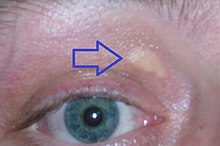User:Mr. Ibrahem/Hypercholesterolemia
| Hypercholesterolemia | |
|---|---|
| Other names | High LDL cholesterol, hypercholesterolaemia, high cholesterol |
 | |
| Xanthelasma palpebrarum, yellowish patches consisting of cholesterol deposits above the eyelids. | |
| Specialty | Cardiology |
| Symptoms | None, xanthomas[1][2] |
| Complications | Heart disease, stroke, peripheral vascular disease[3] |
| Causes | Familial hypercholesterolemia, low thyroid, nephrotic syndrome, cholestasis, alcoholism, diabetes, certain medications like HCTZ[3][1] |
| Risk factors | Family history, diet, inactivity, obesity smoking[3][2] |
| Diagnostic method | Blood tests[1] |
| Treatment | Lifestyle changes, statin[2] |
| Frequency | 39% of adults[4] |
Hypercholesterolemia, also called high cholesterol, is the presence of high levels of cholesterol in the blood.[1] It is type of abnormal blood lipids, along with high triglycerides and low HDL cholesterol.[5][6] There are generally no symptoms.[2] In severe cases xanthomas may occur.[1] Complications may include heart disease, stroke, and peripheral vascular disease.[3]
Causes may include genetic diseases such as familial hypercholesterolemia.[3] Most cases; however, are due to a combination of genetic factors together with diet, inactivity, obesity and smoking.[3][2] Other risk factors include low thyroid, nephrotic syndrome, cholestasis, alcoholism, diabetes, and certain medications like HCTZ.[3][1] Diagnosis is based on blood tests finding a high total cholesterol or LDL cholesterol.[6][1]
Treatment often involves lifestyle changes and medications.[2] Life style changes include exercise and a healthy diet.[1] If lifestyle changes are not sufficient, statin medications are often recommended.[2] Other medications that may be used include ezetimibe, niacin, and PCSK9 inhibitors.[3] Rarely LDL apheresis or liver transplant is performed.[7]
High cholesterol is estimated to affected about 39% of people globally.[4] About 74 million (32%) adults in the United States have high cholesterol.[3] Familial hypercholesterolemia affects about 1 in 250 people.[3] Older people are more commonly affected.[2] Globally it is estimated to cause about 2.6 million deaths per year.[4] Familial hypercholesterolemia was first described in 1938.[8]
References[edit]
- ^ a b c d e f g h "Quick Facts: High Cholesterol". Merck Manuals Consumer Version. Retrieved 8 March 2021.
- ^ a b c d e f g h "Cholesterol". medlineplus.gov. Retrieved 8 March 2021.
- ^ a b c d e f g h i j Ibrahim, MA; Asuka, E; Jialal, I (January 2021). "Hypercholesterolemia". PMID 29083750.
{{cite journal}}: Cite journal requires|journal=(help) - ^ a b c Noubiap, JJ; Nansseu, JR; Bigna, JJ; Jingi, AM; Kengne, AP (17 March 2015). "Prevalence and incidence of dyslipidaemia among adults in Africa: a systematic review and meta-analysis protocol". BMJ open. 5 (3): e007404. doi:10.1136/bmjopen-2014-007404. PMID 25783427.
- ^ Pappan, N; Rehman, A (January 2021). "Dyslipidemia". PMID 32809726.
{{cite journal}}: Cite journal requires|journal=(help) - ^ a b "Hypercholesterolemia - Symptoms, diagnosis and treatment | BMJ Best Practice US". bestpractice.bmj.com. Retrieved 8 March 2021.
- ^ Ito MK, McGowan MP, Moriarty PM (June 2011). "Management of familial hypercholesterolemias in adult patients: recommendations from the National Lipid Association Expert Panel on Familial Hypercholesterolemia". J Clin Lipidol. 5 (3 Suppl): S38–45. doi:10.1016/j.jacl.2011.04.001. PMID 21600528.
- ^ Januzzi, James L. (2011). Cardiac Biomarkers in Clinical Practice. Jones & Bartlett Learning. p. 786. ISBN 978-0-7637-6161-5.
